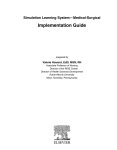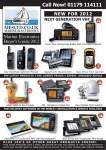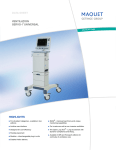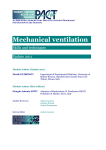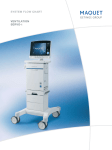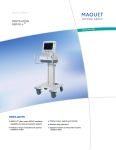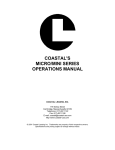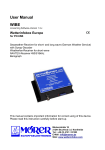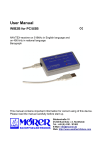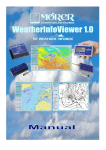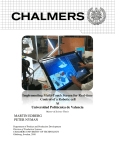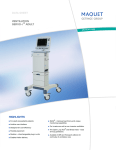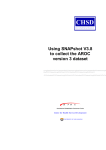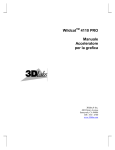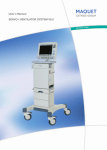Download NAVA and NIV NAVA Pocket Guide
Transcript
POCKET GUIDE NAVA® and NIV NAVA in neonatal settings EMPTY Table of contents 1 2 3 4 5 6 Introduction and background facts Invasive ventilation with NAVA Non invasive ventilation with NAVA NAVA and NIV NAVA features and management tips Glossary References | | | | | | 4 18 30 46 52 54 3 1.2 INTRODUCTION AND BACKGROUND FACTS Introduction Neonatal care is a specialized field focusing on babies in the first few weeks of life. Both in terms of size and development, these patients have special requirements. This pocket guide aims to present Neurally Adjusted Ventilatory Assist (NAVA) in both its invasive and non invasive forms to users working with neonatal intensive care. In order to avoid confusion and information overload, other modes of ventilation used in the context of neonatal care are described separately, so that the user can concentrate on understanding and learning to use NAVA. It should of course be noted that this pocket guide cannot replace the appropriate user’s manual. The first chapter provides a brief description of the physiological background to NAVA, as well as certain important central concepts, such as the Edi signal and the NAVA level, and an outline of the workflow prior to beginning patient ventilation with NAVA or NIV NAVA. It is then followed by two main chapters, one focusing on patient ventilation using invasive NAVA and the other on the non invasive mode, and concludes with a final shared chapter presenting some of the unique features of both modes, along with a few useful management tips relevant to neonatal care. Background and basic concepts Neurally Adjusted Ventilatory Assist, in both its invasive and non invasive forms, can be used on all patients requiring ventilatory assistance (neonatal, pediatric and adult patients), provided that the electrical signal from the brain to the diaphragm is intact and that there is no contraindication for insertion/exchange of a nasogastric tube. 4 1.2 INTRODUCTION AND BACKGROUND FACTS NAVA delivers assist in proportion to and in synchrony with the patient’s respiratory efforts. These efforts are reflected by the Edi signal, which represents the electrical activity of the diaphragm, the body’s principal breathing muscle. Understanding the Edi signal and its use in NAVA and NIV NAVA is essential to successful ventilation using these modes. Physiology of the Edi signal During normal respiration, a spontaneous breath starts with an impulse generated by the respiratory center in the brain. This impulse is then transmitted via the phrenic nerves and electrically activates the diaphragm (excitation), leading to a muscle contraction. The diaphragm contracts into the abdominal cavity, which leads to a descending movement, creating a negative alveolar pressure and an inflow of air. Muscular contraction of the diaphragm is always preceded by an electrical impulse and this electrical activation is controlled by nerve stimuli, and ultimately by the respiratory center in the brain. 5 1.2 INTRODUCTION AND BACKGROUND FACTS The signal that excites the diaphragm is proportional to the integrated output of the respiratory center in the brain and controls the depth and cycling of the breath. Using the Edi signal in NAVA When NAVA is used with the SERVO-i ventilator, the electrical activity of the diaphragm, the Edi signal, is captured by a special catheter (the Edi Catheter), which is fitted with an array of electrodes. Like an ordinary feeding tube, the Edi Catheter is placed in the esophagus. In neonates, the diaphragm, laryngeal and chest wall muscles work in concert to augment the function of every component and thereby protect the fragile tissues in the lungs. 1. 2. 3. 4. 6 1.2 Edi Catheter (with electrodes marked in black – the first is the reference electrode, the others are measuring electrodes and the distance between the measuring electrodes is the Inter Electrode Distance or IED) Esophageal wall Diaphragm Stomach INTRODUCTION AND BACKGROUND FACTS The Edi signal that is picked up by the electrodes on the Edi Catheter is filtered and processed by the Edi Module. The Edi signal is measured in microvolts 62.5 times per second. The processed Edi signal is relayed to the SERVO-i ventilator which will, depending on the NAVA level chosen, then deliver assist to the patient in proportion to and in synchrony with this signal. Basically, NAVA uses the Edi signal to control the ventilator and assist the patient’s breathing in proportion to and synchrony with his or her own effort. The Edi signal serves as a respiratory vital sign in that it provides: continuous monitoring of the respiratory drive decision support for adjusting assist and unloading objective criteria for intubation and extubation decisions. The efficacy of the respiratory muscles and the degree of respiratory demand will determine the degree of respiratory center output. 7 1.2 INTRODUCTION AND BACKGROUND FACTS In a healthy subject, the low amplitude of diaphragm excitation reflects the fact that neuroventilatory coupling is highly efficient and that only about 5% of maximum capacity is used. The signal is displayed on the ventilator screen, enabling the user to monitor this vital sign and to observe and follow the synchrony between patient and ventilator. 8 1.2 INTRODUCTION AND BACKGROUND FACTS An example of an Edi curve for a single patient breath is presented in the diagram below. The vertical green lines represent Edi signals, sampled at a rate of 62.5 times per second. When the preset Edi trigger level is reached, the ventilator will start to deliver assist in proportion to the Edi signal, using the preset NAVA level as the factor by which the signal is multiplied to ensure continuous proportionality. Both NAVA modes, invasive and non invasive, are triggered by an increase in the Edi signal from its lowest value, known as Edi min, rather than a specific Edi level. In the diagram below, the Edi min is 0.3 µV and the trigger level 0.5, which means that the ventilator will be triggered at an absolute level of 0.8 µV. 9 1.2 INTRODUCTION AND BACKGROUND FACTS NAVA and NIV NAVA also employ a pneumatic trigger, based on flow or pressure, as a secondary trigger source. In combination with the Edi trigger, this operates on a first-come-first-served basis. The ventilator will continue to multiply each of the subsequent measured Edi signals (the individual green lines in the diagram above) by the preset NAVA level, resulting in a pressure curve that follows the Edi signal in a smooth and consistent way. 10 1.2 INTRODUCTION AND BACKGROUND FACTS The pressure delivered is derived from the following formula: NAVA level x (Edi signal - Edi min) + PEEP The pressure curve in both NAVA and NIV NAVA follows the Edi signal pattern. When the Edi signal has fallen to 70% of its peak value, the patient is allowed to exhale and the ventilator no longer offers any assist until the next breath is initiated and the trigger level is again reached. 11 1.2 INTRODUCTION AND BACKGROUND FACTS As long as the patient has an Edi Catheter in position, the Edi signal can in addition be monitored in all modes of ventilation, invasive and non invasive, as well as in Standby, including values for both Edi peak and Edi min. The values are also trended in all modes, as well as in Standby. The NAVA level The NAVA level is the factor by which the Edi signal is multiplied to adjust the amount of assist delivered to the patient. This assist is thus proportional to the patient’s Edi and as such, it follows a physiological pattern. 12 1.2 INTRODUCTION AND BACKGROUND FACTS The set NAVA level reflects the amount of work of breathing that the SERVO-i ventilator will take over from the patient. The appropriate NAVA level varies for different patients since they require different assist levels. It may also need adjusting over time in the same patient. The NAVA level is typically set to between 1.0 and 4.0 cmH20/µV. The range of settings is 0.0 to 15.0 cmH20/µV. Insertion and positioning of the Edi Catheter Select the appropriate Edi Catheter for the patient. You need to know the patient’s height and weight. The table below provides more details. 8 Fr 100 cm IED (Inter Electrode Distance) 8 mm < 55 cm 1.0 - 2.0 kg 6 Fr 50 cm 6 mm < 55 cm 0.5 - 1.5 kg 6 Fr 49 cm 6 mm Patient height Patient weight 45 - 85 cm Edi Catheter size Insert the Edi Module into the SERVO-i and connect the Edi Cable. Perform the Edi Module function check. 13 1.2 INTRODUCTION AND BACKGROUND FACTS Measure the distance from the bridge of the Nose (1) to the Earlobe (2) and then to the Xiphoid process (3). This is the NEX measurement. Make a note of it. Calculate the insertion distance (Y) for the Edi Catheter. This will depend on whether the Edi Catheter is inserted orally or nasally, as well as on the size of the Edi Catheter. Use the appropriate table as shown below. Insertion distance Y for nasal insertion Fr/cm Calculation of Y 14 1.2 8 Fr 100 cm NEX cm x 0.9 + 8 = Y cm 6 Fr 50 cm NEX cm x 0.9 + 3.5 = Y cm 6 Fr 49 cm NEX cm x 0.9 + 2.5 = Y cm INTRODUCTION AND BACKGROUND FACTS Insertion distance Y for oral insertion Fr/cm Calculation of Y 8 Fr 100 cm NEX cm x 0.8 + 8 = Y cm 6 Fr 50 cm NEX cm x 0.8 + 3.5 = Y cm 6 Fr 49 cm NEX cm x 0.8 + 2.5 = Y cm Examples: - Infant – height 40 cm, weight 900 g Selected Edi Catheter – 6 Fr 49 cm Insertion – nasal NEX – 12 cm Insertion distance Y = 12 x 0.9 + 2.5 = 12.3 cm Infant – height 46 cm, weight 1.8 kg Selected Edi Catheter – 6 Fr 50 cm Insertion – oral NEX – 15 cm Insertion distance Y = 15 x 0.8 + 3.5 = 15 cm Dip the Edi Catheter into water for a few seconds. Do NOT use lubricants as this may destroy the Edi Catheter coating and interfere with the measurement of the Edi signal. Insert the Edi Catheter to the Y value calculated above. Connect the Edi Catheter to the Edi Cable. Open the “Neural access” menu and select “Edi Catheter positioning” to confirm the position of the Edi Catheter. 15 1.2 INTRODUCTION AND BACKGROUND FACTS Verify the position of the Edi Catheter by analyzing the ECG waveforms. Ideally, P and QRS waves are present in the top leads, while the P waves gradually decrease and disappear in the lower leads, where QRS amplitude also decreases. Check that the Edi scale is fixed and that it is set appropriately (greater than or equal to 5 µV). If Edi deflections are present, observe which leads are highlighted in blue. - - - - 16 1.2 If the second and third leads are highlighted in blue, secure the Edi Catheter in this position after marking it at its final position and making a note of the distance in centimeters. If the top leads are highlighted, pull out the Edi Catheter in steps corresponding to the Inter Electrode Distance (IED, measured in millimeters) until the blue highlight appears in the center. Do not exceed four times the IED, Mark the Edi Catheter at its final position. If the bottom leads are highlighted, insert the Edi Catheter further in steps corresponding to the IED until the blue highlight appears in the center. Again, do not exceed four times the IED. Mark the Edi Catheter at its final position. If the Edi signal is very low, there will be no blue highlights. If this happens, evaluate the Edi signal as described below. INTRODUCTION AND BACKGROUND FACTS Secure the Edi Catheter in position once the position has been verified. Check first that the marking on the Edi Catheter is in the right place and observe the ECG waveforms and their blue highlights. Make sure that the Edi Catheter is not secured to the endotracheal tube. Record the insertion length. Important: Always follow hospital routines to check the position of the Edi Catheter when it is used as a gastric feeding tube. Evaluate the Edi signal. A low or absent Edi may be due to any of the following: hyperventilation sedation muscle relaxants neural disorders If possible, perform an expiratory hold and verify that the positive Edi deflection coincides with a negative deflection in the pressure waveform. Edi Catheter positioning may be reconfirmed after 1-2 hours if minor adjustments are necessary. SUMMARY Select Edi Catheter and measure NEX, calculating the insertion distance, Y. Dip Edi Catheter in water and insert. Verify the position in the positioning window. Secure the Edi Catheter. 17 1.2 INVASIVE VENTILATION WITH NAVA Starting and running NAVA The information below covers the procedures involved in starting and running the NAVA mode. Press “Neural access” and select “NAVA preview”. The gray curve then displayed on the user interface below shows the estimated pressure based on the Edi and the set NAVA level. 18 1.2 INVASIVE VENTILATION WITH NAVA Simply press “NAVA level” and use the main rotary dial to set it appropriately. The NAVA level range is 0 to 15 cmH2O/µV. One way to select the initial NAVA level is to try the level that will produce the same pressure as that used in the current ventilation mode, or perhaps slightly lower. By accepting and pressing “Close”, the selected NAVA level is saved to the NAVA ventilation mode window. 19 1.2 INVASIVE VENTILATION WITH NAVA To set the parameters for operating the NAVA mode, choose “NAVA” in the “Select ventilation mode” window. This opens the “Set ventilation mode” parameters window. The NAVA level displayed here is the initial one saved (as outlined in the point above) from the “NAVA preview” window. The other two basic parameters are PEEP (cmH2O) and oxygen concentration (%). Trigg. Edi has a default setting of 0.5 µV and the range 0-2 µV. The value set here is the one that will trigger the ventilator to assist the patient. 20 1.2 INVASIVE VENTILATION WITH NAVA The remaining parameters refer to NAVA Pressure Support (NAVA (PS) – Trigger Sensitivity, Inspiratory Cycle off (%) and PS above PEEP (cmH2O). NAVA (PS) is the mode to which the ventilator automatically switches under certain specific circumstances (see diagram and information in the section below). It is therefore important to set adequate values here; otherwise the patient’s Edi signal may be affected and the ventilator may be unable to switch back to NAVA. NAVA (PS) and Backup are described in greater detail later in this chapter. Finally, the column for “Backup ventilation” has three parameters that can be set by the user – PC above PEEP (cmH2O), Resp. Rate and Ti/I:E. Default settings are used for the following parameters: Infant parameters Ti/I:E ratio 0.5 s/1:2 Respiratory rate 30 breaths/minute Inspiratory rise time 0.15 s/5% The backup pressure level, respiratory rate and inspiratory time or I:E ratio are all adjustable. The default settings can be adjusted in the Edit startup configuration window. 21 1.2 INVASIVE VENTILATION WITH NAVA Set appropriate alarm limits in the Alarm profile window. The apnea alarm for infants can be set between 5 and 45 seconds. It is important to set a suitable upper limit for pressure. The maximum available pressure level is 5 cmH2O below the preset upper pressure limit. Appropriate values should also be set for the patient’s minute volume, respiratory rate and end expiratory pressure. The alarms’ sound level and the apnea time are also adjusted here. SUMMARY Select NAVA preview via "Neural access". Adjust the NAVA level. Accept and press "Close" to save the initial NAVA level. Open the NAVA mode window and adjust settings. Set appropriate values for NAVA (PS) and NAVA Backup. Accept and proceed with NAVA ventilation. Remember to set appropriate alarm limits. 22 1.2 INVASIVE VENTILATION WITH NAVA Switching between NAVA, NAVA (PS) and NAVA (Backup) When running invasive NAVA, the ventilator has several modes between which it switches freely under specific conditions. These are described and explained here. 23 1.2 INVASIVE VENTILATION WITH NAVA Switching from NAVA to NAVA (PS) The Edi respiratory rate differs from the pneumatic respiratory rate by more than 25% for at least 5 seconds. The calculated respiratory rates are based on the last 20 seconds. The Edi Ti/Ttot is more than 0.5, calculated over the last 20 seconds if the Edi Catheter position is classified as invalid. The Edi Ti/Ttot is more than 0.6, calculated over the last 20 seconds if the Edi Catheter position is classified as valid. The Edi Catheter is disconnected. There is ECG leakage into the Edi signal. Switching from NAVA (PS) to NAVA The Edi respiratory rate differs from the pneumatic respiratory rate by less than 20%. At least 7 of the last 10 breaths are classified as being in synchrony with the Edi signal. Note: Pneumatic respiratory rate and Ti/Ttot are shown on the user interface. Edi respiratory rate and Edi Ti/Ttot are not shown on the user interface. Switching from NAVA to NAVA (Backup) Apnea with a permanently low Edi signal and no pneumatic trigger. Switching from NAVA (Backup) to NAVA An adequate Edi signal can be detected. 24 1.2 INVASIVE VENTILATION WITH NAVA Switching from NAVA (PS) to NAVA (Backup) When the ventilator is in NAVA (PS) for any of the above reasons, and the pneumatic trigger can no longer be detected, the ventilator will switch to backup mode (Pressure Control). There are, however, certain restrictions on the number of times the ventilator may switch back and forth automatically between NAVA and NAVA (Backup). The ventilator will thus lock in backup ventilation if: - the patient switches between NAVA and NAVA (Backup) more than three times in the space of two minutes OR - the patient only triggers a single breath with the Edi signal to interrupt each of two consecutive backup periods. A dialog box will then open where the user may either review the ventilatory settings or return to the supported mode by pressing one of the two buttons displayed. Alarms for invasive NAVA The following are high priority alarms. Asynchrony alarm In case of asynchrony, the ventilator will switch back and forth without triggering an alarm until one of the following conditions is fulfilled: - the ventilator has been in NAVA (PS) for more than 120 seconds; there have been six switches from NAVA to NAVA (PS) in the last five minutes. 25 1.2 INVASIVE VENTILATION WITH NAVA In either case, the asynchrony alarm will be activated and the message “Pneumatic-Edi out of synch” will appear, since the measured Edi signal is out of phase with the pressure and flow signals generated by the patient. There will also be a message to tell the user to check the Edi Catheter position. In addition, the user should check and if necessary adjust the trigger settings. The ventilation mode can also be changed. When the asynchrony alarm has been activated, the ventilator will as usual search for synchrony indices. As soon as synchrony is re-established, the message “Pneumatic-Edi synch restored” will be displayed. Press the OK button or wait for ten seconds, and the ventilator will switch back to NAVA. You can also choose to return to NAVA manually by pressing the “Back to NAVA” key on the user interface if the patient’s Edi signal is in synchrony with the pneumatic breath. If asynchrony is still detected, a message will appear followed by a question. Users then need to confirm that they wish to return to NAVA. No Edi monitoring alarm The message “Edi monitoring not active” appears when the NAVA mode is activated without an Edi Module being connected or if the Edi Catheter is not properly connected. If this occurs, simply insert the Edi Module or adjust the Edi Catheter. Regulation pressure limited message "Regulation pressure limited" appears as a text message activated during NAVA at a level 5 cmH20 below the set Upper Pressure Limit. If you then increase the NAVA level, the ventilator will make a beeping sound to draw your attention to the message. The maximum available pressure level is thus 5 cmH20 below the preset upper pressure limit. 26 1.2 INVASIVE VENTILATION WITH NAVA One way to manage the NAVA level When ventilating neonates with NAVA, treatment may normally be started at a NAVA level that will ensure that the pressure delivered is the same as, or slightly lower than, the set Pressure Support level. The NAVA level is then gradually titrated to a level that will ensure comfortable unloading of the patient. The Edi signal provides the necessary information for performing this procedure efficiently, as summarized below. Throughout this procedure, the patient should be carefully observed for signs of discomfort or hemodynamic instability. Once a reliable Edi signal with a satisfactory amplitude has been obtained, activate the NAVA preview window and set a NAVA level that ensures that the pressure delivered is equal to or slightly below the set Pressure Support level. Set an Upper Pressure Limit that is acceptable to the patient. The NAVA level is then increased in steps of 0.1 cm H2O/µV with the aim of achieving a decrease in the Edi signal. If the aim is, for example, to unload 50% of the patient’s work of breathing, the target for the decrease in the Edi signal will be 50%. 27 1.2 INVASIVE VENTILATION WITH NAVA The Edi signal is followed carefully while the NAVA level is slowly increased in small increments. The Edi signal helps the clinician to quantify and continuously evaluate the patient’s respiratory work. Once the target is reached, the Edi signal should be followed without changing the NAVA level. A decrease in the Edi signal with a maintained tidal volume indicates an improvement in neuromuscular coupling. One way to wean patients from invasive NAVA This chapter describes one procedure that can be followed when weaning a patient from NAVA. When the patient is on NAVA, an objective measure of the patient’s progress becomes available – the Edi signal. The first sign to look for is a decline in the Edi signal with unchanged tidal volumes. This represents an improvement in neuromuscular coupling in the sense that diaphragm performance is unchanged at a lower level of stimulation. As soon as this situation is achieved, the airway pressure will be lower. The patient is in effect giving us a signal that he or she is now ready to be weaned. For all practical purposes, the patient can then be left with an essentially unchanged NAVA level and will wean him or herself off the ventilator, while we watch the progress in the shape of a falling Edi signal. The process may however be speeded up to allow earlier disconnection from the ventilator. The procedure suggested below is one example of how this may be done. 28 1.2 INVASIVE VENTILATION WITH NAVA Weaning procedure example: 1. 2. 3. 4. 5. The first sign that it is possible to wean the patient is a decline in the Edi signal with maintained tidal volume. Please remember the following differential diagnosis – sedation bolus or increase in maintenance dose of opiates/sedatives. If an increase in sedation is not the cause of the decline in the Edi signal, however, then the decrease provides confirmation of an improvement in neuromuscular coupling. The mechanical efficiency of the diaphragm has improved and the patient will be receiving less support – weaning has in effect been started automatically. When the patient is stable and the tidal volume is unchanged while the Edi signal is declining or unchanged, reduce the NAVA level in steps of 0.1-0.2 cmH2O/µV. If VT is reduced and the Edi signal increases disproportionally, go back to the previous setting. The reaction may indicate one of the two following situations: a. The patient is not yet ready to be weaned. Allow the patient to rest on the previous setting and try again later. b. The initial assist is too low (look for a slow upstroke in the Edi and flow curve, and an increase in neural Ti). Weaning progress can be monitored by the decline in the Edi signal and peak pressure. SUMMARY While keeping the NAVA level unchanged, verify a decrease in the Edi amplitude with a maintained tidal volume. Decrease the NAVA level in steps of 0.1-0.2 cmH2O/µV. Observe a decrease in peak pressure minus PEEP with a maintained tidal volume. 29 1.2 NON INVASIVE VENTILATION WITH NAVA Introduction to NIV NAVA Synchronized non invasive respiratory assist enables smooth transition to natural breathing and provides proportional assist in synchrony with the patient’s own breathing efforts. Patient and ventilator are thus in synchrony. NIV NAVA does not rely on a pneumatic signal. Both triggering and cycle off of the breath rely on the Edi signal and are therefore independent of leakage. There are several types of patient interface. For neonates, the most commonly used interfaces are nasal prongs or nasal masks, although nasopharyngeal tubes may also be used (see management tips). Monitoring the respiratory drive The Edi signal serves as a respiratory vital sign in that it provides: continuous monitoring of the respiratory drive decision support for adjusting assist and unloading objective criteria for intubation and extubation decisions. 30 1.2 NON INVASIVE VENTILATION WITH NAVA Starting and running NIV NAVA Settings To access NIV NAVA, the user must be in the Standby position and select the relevant patient category (infant) and non invasive ventilation. Please note that when NIV is selected, the frame on the screen turns from grey to yellow. In the Select Ventilation Mode window, the user selects NIV NAVA and the Set Ventilation Mode window opens. This is where the parameters are set for NIV NAVA. 31 1.2 NON INVASIVE VENTILATION WITH NAVA Basic settings: NAVA level – range 0.0 to 15.0 cmH2O/µV. Default – 0.5 cmH2O/µV. For NIV NAVA, the estimated pressure delivered will be: NAVA level x (Edi peak – Edi min) + PEEP + 2 cmH2O PEEP – range 2 to 20 cmH2O O2 concentration – range 21 to 100% Trigg. Edi – range 0.0 to 2.0 µV Backup ventilation for NIV NAVA is Pressure Control. 32 1.2 NON INVASIVE VENTILATION WITH NAVA Backup parameters Infant parameters Ti/I:E ratio 0.5 s/1:2 Respiratory rate 30 breaths/minute Inspiratory rise time 0.15 s/5% The backup settings should be chosen so as to ensure adequate ventilation in case of apnea. It is important to consider that apnea is particularly frequent in infants, particularly premature infants, and the backup settings should be made with this in mind. When suitable values have been selected, press Accept. Before starting ventilation by pressing the Start button in the bottom left corner of the user interface, it is important to check the alarm profile. It is important to set a suitable upper limit for pressure. The maximum available pressure level is 5 cmH2O below the preset upper pressure limit. Appropriate values should also be set for the patient’s minute volume, respiratory rate and end expiratory pressure. The alarms’ sound level and the apnea time are also adjusted here. 33 1.2 NON INVASIVE VENTILATION WITH NAVA The Regulation pressure limited message appears when Ppeak is 5 cmH2O below the upper pressure limit. The maximum available pressure level is thus 5 cmH2O below the preset upper pressure limit. The maximum peak pressure is 32 cmH2O. Since leakage often varies during non invasive ventilation, alarms may be activated frequently, which may be perceived as disturbing, particularly to the patient. It is therefore possible to set audible alarms to “Audio off” by pressing the bell on the relevant alarm. This applies to all patient related alarms except the high pressure alarm. When appropriate values have been set, press Accept. If the patient is already being ventilated in NIV PS or NIV PC, the initial NAVA level can be set in the NAVA preview window, which is opened via the Neural access fixed key. There are thus different ways to start NIV NAVA. 34 1.2 NON INVASIVE VENTILATION WITH NAVA SUMMARY If NIV NAVA is the first ventilation choice, the NAVA preview window cannot be used. The NAVA level is instead set in the Set ventilation mode window by choosing a low level and then gradually increasing to a level at which the patient is adequately unloaded. The process of setting and optimizing the NAVA level is discussed in a separate section below. If the patient is being ventilated with NIV PS, NIV PC, or an invasive mode other than invasive NAVA, the NAVA preview window can also be used – the user presses “NAVA level” in this window and uses the main rotary dial to set it appropriately. Generally, the first NAVA level should be low and then slowly increased in steps of 0.1 cmH2O/µV. Running NIV NAVA After starting ventilation by pressing the Start button in the bottom left corner of the user interface, a waiting position for NIV NAVA will be initiated, which gives the user an opportunity to adjust the ventilator and/or the patient interface (i.e. the mask, prongs or other). The time shown is counted by the ventilator from the time that the waiting position is entered. Ventilation begins when one of the following criteria has been met: the ventilator detects that the patient is connected to the ventilator the user presses the Start ventilation soft key. 35 1.2 NON INVASIVE VENTILATION WITH NAVA If neither of these criteria has been met within two minutes, an alarm will be activated to remind the user that it is appropriate to start ventilation. During the waiting phase, all audible patient related alarms are deactivated and no ventilation is delivered. There is however a bias flow of 7.5 l/min. When the Start ventilation button is pressed, NIV NAVA will be started without further delay. The screen shot below shows the SERVO-i ventilator running in NIV NAVA. The screen displays the pressure, flow, volume and Edi curves, as well as measured values relating to each curve on the right. Note that the Edi deflections are synchronous with the assist delivered. 36 1.2 NON INVASIVE VENTILATION WITH NAVA NIV NAVA alarms No patient effort alarm If the Edi signal disappears, the ventilator will sound a high priority alarm after the set apnea time and the message ”No patient effort” will appear on the screen. The ventilator will automatically switch to Backup ventilation. The backup mode for NIV NAVA is Pressure Control and the function of the third and fourth direct access knobs at the bottom of the screen is changed so that they can be used to adjust the respiratory rate and PC above PEEP. Once the ventilator detects a valid Edi signal again, it will automatically return from backup ventilation to NIV NAVA (please note that the ventilator will only return to NIV NAVA if triggered by the Edi, not if there is a pneumatic trigger). There is no limit on the number of times the ventilator can switch back and forth between NIV NAVA and backup ventilation. 37 1.2 NON INVASIVE VENTILATION WITH NAVA Leakage out of range alarm The ventilator will compensate for leakage of up to 25 l/min for infants. If leakage is excessive (>25 l/min for infants during expiration) or if the patient is disconnected, the ventilator will pause and issue a high priority alarm. A dialog appears, stating that leakage is too high and recommending that the patient circuit should be checked. The message Leakage out of range also appears at the top of the screen. When this happens, a constant disconnect flow is delivered. The flow depends on the setting of the Disconnect flow function in the Edit startup configuration window. The default value is 7.5 l/min. 38 1.2 NON INVASIVE VENTILATION WITH NAVA Once leakage has been reduced or the patient has been reconnected, ventilation will automatically resume and the screen dialog will disappear after three breaths. It is also possible to start ventilation manually by pressing the “Resume ventilation” button. This brings the ventilator out of its pause position and returns it to NIV NAVA, but a message (“Operator-initiated breath”) will appear and the alarm will still be active. It may be noted that NIV NAVA is less sensitive to autotriggering at high leakage levels because the pneumatic trigger is deactivated when 60% of the maximum leakage compensation is reached. Disconnect flow The Disconnect flow can be set in the Edit startup configuration window. The following settings are possible: Low flow - 7.5 l/min High flow - 15 l/min for infants Disabled - No pause in ventilation in case of high leakage. The SERVO-i will continue to deliver assist even when leakage is excessive. The Leakage out of range alarm will then go from high priority to medium priority. 39 1.2 NON INVASIVE VENTILATION WITH NAVA There is also a special low priority leakage fraction alarm for the NIV NAVA infant option. It is activated if leakage is > 95%. This feature is useful when ventilating infants with NIV NAVA, as it gives personnel the possibility to adjust prongs or other non invasive interfaces that have come loose. The leakage fraction alarm function is enabled via Biomed and this function is only available in the NIV NAVA infant option. Check catheter position/RR and HR coupling alarm In this high priority alarm, RR refers to the respiratory rate and HR to the heart rate. This alarm is activated when there is leakage of the ECG signal into the Edi signal. The ventilator switches automatically to backup ventilation. The Edi Catheter position should be checked by going to the Edi Catheter positioning window (via the Neural access fixed key), where adjustments can be made to the position of the Edi Catheter. The alarm will then disappear and the ventilator should automatically return to NIV NAVA. 40 1.2 NON INVASIVE VENTILATION WITH NAVA Unreliable Edi signal alarm A further high priority alarm is ”Unreliable Edi signal”, which occurs in cases of extreme asynchrony between the detected Edi signal and the pneumatic parameters. The alarm is activated if one or more of the following conditions are fulfilled during NIV NAVA ventilation: the Edi respiratory rate differs from the pneumatic respiratory rate by more than 25% for at least 5 seconds, assuming that leakage is low. The calculated respiratory rates are based on the last 20 seconds. the Edi Ti/Ttot is more than 0.5, calculated over the last 40 seconds, if the Edi Catheter position is classified as invalid. the Edi Ti/Ttot is more than 0.6, calculated over the last 40 seconds, if the Edi Catheter position is classified as valid. Note: The pneumatic respiratory rate and Ti/Ttot are shown on the user interface. The Edi respiratory rate and Ti/Ttot are not shown on the user interface. This alarm does not cause the ventilator to switch automatically to backup ventilation. Instead the user should press the alarm fixed key for more details. When the “Bell” fixed key on the right of the user interface is pressed, a dialog box opens in which the user is recommended to check the Edi Catheter position and asked if he wishes to turn the alarm audio off for the duration of the alarm situation. Once the Edi Catheter position has been corrected, the alarm should disappear and NIV NAVA ventilation should continue normally. 41 1.2 NON INVASIVE VENTILATION WITH NAVA Check catheter position/Edi invalid alarm Another high priority alarm concerns the Edi Catheter and occurs when there is no valid Edi signal for the ventilator to work with, for example if the Edi Catheter or Edi cable have been accidentally disconnected. The ventilator then switches to backup ventilation and a dialog box opens. As soon as the Edi Catheter has been reconnected and the ventilator detects a valid Edi signal, the ventilator will switch back to NIV NAVA. Apnea audio delay It is also possible to set an Apnea audio delay to between 0 and 30 seconds. Again, this only applies to infants. If, for example, the user sets the apnea audio delay to 20 seconds, while the apnea time has been set to 10 seconds, the SERVO-i will, after 10 seconds with no Edi signal, activate the “No patient effort” visual alarm and display the message “Alarm audio paused”. If the Edi signal does not return within the next 20 seconds, a high priority audio alarm signal will be activated. 42 1.2 NON INVASIVE VENTILATION WITH NAVA One way to manage the NAVA level When ventilating in NIV NAVA, the treatment is normally started at a low NAVA level and then gradually titrated to the level that will ensure comfortable unloading of the patient. The Edi signal provides the information needed to perform this procedure efficiently. If possible, start by setting the NAVA level to 0 (for 30-60 seconds). The resulting Edi peak value that is then registered will provide information that allows the clinician to assess the total muscle load, as well as any muscular weakness. The NAVA level is then increased in steps of 0.1 cm H2O/µV with the aim of achieving a decrease in the Edi signal. If the aim is, for example, to unload 50% of the patient’s work of breathing, the target for the decrease in the Edi signal will be 50%. The Edi signal is followed carefully while the NAVA level is slowly increased in small increments. The Edi signal helps the clinician to quantify and continuously evaluate the patient’s respiratory work. Once the target is reached, the Edi signal should be followed without changing the NAVA level. A decrease in the Edi signal with a maintained tidal volume indicates an improvement in neuromuscular coupling. 43 1.2 NON INVASIVE VENTILATION WITH NAVA One way to wean patients from NIV NAVA As for invasive NAVA, weaning from NIV NAVA is largely a matter of self-weaning. The Edi signal can be used during ventilation with NIV NAVA as an objective measure of the patient’s progress. The first sign to look for is a decline in the Edi signal with unchanged tidal volumes. This represents an improvement in neuromuscular coupling in the sense that diaphragm performance is unchanged at a lower level of stimulation. As soon as this situation is achieved, the airway pressure will be lower. The patient is in effect giving us a signal that he or she is now ready to be weaned. For all practical purposes, the patient can then be left with an essentially unchanged NAVA level and will wean him-or herself off the ventilator, while we watch the progress in the shape of a falling Edi signal. The process may however be speeded up to allow earlier disconnection from the ventilator. The procedure suggested below is one example of how this may be done. Weaning procedure example: 1. 2. 44 1.2 The first sign that it is possible to wean the patient is a decline in the Edi signal with maintained tidal volume. Please remember the following differential diagnosis – sedation bolus or increase in maintenance dose of opiates/sedatives. If an increase in sedation is not the cause of the decline in the Edi signal, however, then the decrease provides confirmation of an improvement in neuromuscular coupling. The mechanical efficiency of the diaphragm has improved and the patient will be receiving less support – weaning has in effect been started automatically. NON INVASIVE VENTILATION WITH NAVA 3. 4. 5. When the patient is stable and the tidal volume is unchanged while the Edi signal is declining or unchanged, reduce the NAVA level in steps of 0.1-0.2 cmH2O/µV. If VT is reduced and the Edi signal increases disproportionately, go back to the previous setting. The reaction may indicate one of the two following situations: a. The patient is not yet ready to be weaned. Allow the patient to rest on the previous setting and try again later. b. The initial assist is too low (look for a slow upstroke in the Edi and flow curve, and an increase in neural Ti). Weaning progress can be monitored by the decline in the Edi signal and peak pressure. SUMMARY While keeping the NAVA level unchanged, verify a decrease in the Edi amplitude with a maintained tidal volume. Decrease the NAVA level in steps of 0.1-0.2 cmH2O/µV. Observe a decrease in peak pressure minus PEEP with a maintained tidal volume. 45 1.2 NAVA AND NIV NAVA FEATURES AND MANAGEMENT TIPS The NAVA respiration cycle Since the Edi signal varies with each breath, the assist pressures will vary accordingly. In summary, inspiration will start when the patient triggers a breath and gas flows into the lungs at a varying pressure proportional to the patient’s Edi signal. The breath may be triggered either by the Edi or pneumatically, by flow or pressure. The assist to the patient will remain proportional to the patient’s Edi signal. The maximum time for inspiration is 2.5 seconds for adults and 1.5 seconds for infants. Expiration begins when the Edi decreases below 70% of the peak value during ongoing inspiration (40% for low Edi signals), or when the pressure increases 3 cmH2O above the inspiratory target pressure, or if the Upper Pressure Limit is exceeded, or when the maximum time for inspiration specified above is exceeded. Trigger colors T Edi trigger indicator T Flow/pressure trigger indicator Using the Edi Catheter as a feeding tube The Edi Catheter is a single-use gastric feeding tube with an array of 10 electrodes (nine measuring and one reference electrode). The Edi catheter has been validated for use for 5 days, both for feeding and when using the NAVA function. 46 1.2 NAVA AND NIV NAVA FEATURES AND MANAGEMENT TIPS Noting Edi Catheter insertion length Remember to mark the Edi Catheter at its final position and make a note of the final distance in centimeters in the patient chart. Suctioning During suctioning, or in case of patient disconnection, it is important to use the Suction Support function to avoid activating the asynchrony alarm (see the Alarms chapter below). The function is not used when a closed suction system is in use. What happens if… … the patient is apneic: In case of apnea, the SERVO-i will automatically switch to Backup ventilation, which is the Pressure Control mode. The apnea time is set under the alarm profile. … the Edi Catheter has been accidentally removed: If the Edi Catheter is pulled out by mistake, the SERVO-i will automatically switch to NAVA (PS) for invasive NAVA or to NAVA (Backup) for non invasive NAVA. … there is no Edi signal, or if it is low: Check that the Edi Catheter is correctly placed and connected by using the Edi Catheter Positioning Window. If it is, check the patient for signs that the PS level is too high, or of hyperventilation or oversedation. The Ventilation Record Card The Ventilation Record Card enables patient data and screen shots to be transferred from the SERVO-i to a computer, where they can be accessed. This feature is useful for teaching as well as for diagnostic purposes. For more details, refer to the relevant SERVO-i training material and user manuals. 47 1.2 NAVA AND NIV NAVA FEATURES AND MANAGEMENT TIPS Patient interfaces for NIV NAVA A range of different types of patient interface can be used when ventilating neonatal patients with NIV NAVA. They include nasal masks and prongs and they come in a variety of sizes to suit all patients. The text below describes the Miniflow neonatal system. For more detailed information, the user is referred to the relevant User’s Manual from Medin Innovations GmbH. Measure the circumference of the baby’s head with the measuring tape. Select a bonnet of the correct size – it has to fit loosely. Put the bonnet on the baby’s head – pull the bonnet as far down towards the baby’s eyes as possible. Choose either prongs or mask – always use the largest possible prongs. You can place the measuring tape beneath the baby’s nose to see the distance between the nostrils. Connect the prongs or mask to the Miniflow. Thread the separate strips provided with the bonnet through the two holes on either side of the prongs or mask. 48 1.2 NAVA AND NIV NAVA FEATURES AND MANAGEMENT TIPS Choose the most suitable angle for the Miniflow connection – either 45° for babies weighing more than 1000 g or 60º for babies weighing less than 1000 g. Open the Velcro tube fastener on the bonnet. Place the tubes on either side of the central part of the Velcro tube fastener. Either place the mask over the baby’s nose, or insert the prongs halfway into the baby’s nostrils. Fasten the strips onto the bonnet below the baby’s ears. Fixate the tubes in the Velcro fastener on the bonnet. If desired, tie the top of the bonnet using the bonnet’s white fabric strips. Important: - If prongs are used, the semicircular edge of the base must point towards the baby’s mouth. Insert the prongs only halfway into the baby’s nostrils. The base of the prongs should not be in contact with either the baby’s nose or the skin below the nose. Do not pull the strips too tight. The Miniflow’s tubes should be angled so that the highest point is located at the baby’s nose to prevent any water from flowing back to the baby’s airways. Please note, before starting ventilation with NIV NAVA, it is vital to prepare ahead and have all necessary interfaces and connections ready for use. Disconnection of the Edi Module If the Edi Module becomes disconnected, the SERVO-i will automatically switch to NAVA (PS) in invasive NAVA or to PC in non invasive NAVA. An alarm will also be activated. 49 1.2 NAVA AND NIV NAVA FEATURES AND MANAGEMENT TIPS Scale settings It is important to verify that the Edi scale is fixed and set appropriately (i.e. greater than or equal to 5 µV). Avoid clipping the Edi signal by imposing too low an upper limit on the scale. NAVA and Heliox NAVA can be used together with Heliox. Trends Trends are extremely useful when following a patient’s progress on NAVA. Coughing and hiccups If a patient is suffering from hiccups, they may trigger the ventilator and cause a short assist delivery. If a patient coughs, NAVA will provide assist during the inspiration phase prior to the cough, and the expiratory valve will open during the coughing itself. The usual safety mechanisms, such as the Upper Pressure Limit, are in place to handle coughing while using the NAVA mode. Titrating the PEEP level An important parameter to optimize when ventilating patients in NAVA is the PEEP level. A titration procedure for optimizing the PEEP level has been described in an article by Brander and colleagues. The article concludes that during NAVA ventilation using an adequate NAVA level, increasing PEEP reduces respiratory drive, and monitoring the ratio of tidal volume to Edi signal (the neuroventilatory index) during PEEP changes allows identification of a PEEP level at which tidal breathing occurs at minimal Edi cost. 50 1.2 NAVA AND NIV NAVA FEATURES AND MANAGEMENT TIPS NIV NAVA – independent of leakage This mode of ventilation is based on a neural signal (the Edi signal) and the triggering and cycle off of the breath are thus unaffected by leakage. Monitoring the Edi signal – a respiratory vital sign The Edi signal can be monitored in all modes of ventilation, as well as in the standby position. This includes Edi peak and Edi min values on a breath-by-breath basis, and these are trended and can be followed in the trend graphs. This enables clinicians to follow an important respiratory parameter easily and reliably at a level not previously accessible in practical clinical work. Since the Edi signal reflects the patient’s own respiratory drive and neural effort, it can be used as a respiratory vital sign that is continually monitored. It provides crucial information about the patient’s ability or inability to breathe spontaneously, as well as about synchrony, or lack of synchrony, between patient and ventilator. 51 1.2 GLOSSARY List of terms CMV - Controlled Mechanical Ventilation. ECG – electrocardiogram, a recording of the electrical activity of the heart. Edi – the electrical activity of the diaphragm. Varying versions of the acronym EAdi are sometimes used to denote the same thing. Edi peak – the highest value of the Edi signal during a single breath cycle. Edi min – the lowest value of the Edi signal during a single breath cycle. Fr – abbreviation for French. The French catheter scale is commonly used to measure the outer diameter of cylindrical medical instruments including catheters. In millimeters, the diameter is equal to the number of French units divided by 3. IED – inter-electrode distance, the distance in millimeters between two measuring electrodes on the Edi Catheter. MV – minute volume. MVe – expiratory minute volume. NAVA – neurally adjusted ventilatory assist, an optional mode of ventilation for the SERVO-i that mimics normal respiration and enhances patient-ventilator interaction. NAVA level – the “gain factor” by which the patient’s Edi signal is multiplied to deliver assist in proportion to the patient’s own breathing effort. NEX – measurement developed specifically to help with the insertion and positioning of the Edi Catheter. The distance measured is from the bridge of the Nose to the Earlobe and then to the tip of the Xiphoid process. NIV NAVA – non invasive neurally adjusted ventilatory assist. P mean – mean airway pressure. P peak – maximum inspiratory pressure. 52 1.2 GLOSSARY PEEP – positive end expiratory pressure, measured in cmH20. Ti/Ttot – ratio of inspiration time to total breathing cycle time. Trigg. Edi – neurally triggered assist (i.e. triggered by the patient’s Edi signal rather than pneumatically) is triggered by an increase in the Edi from the Edi min, rather than at an absolute level. VT – tidal volume, i.e. the volume inspired and expired with each normal breath. VTe – expiratory tidal volume. VTi – inspiratory tidal volume. 53 1.2 REFERENCES Beck J, Gottfried SB, Navalesi P, Skrobik Y, Comtois N, Rossini M, Sinderby C. Electrical activation of the diaphragm during pressure support ventilation in acute respiratory failure. Am J Respir Crit Care Med 2001; 164(3): 419-424. Navalesi P, Costa R. New modes of mechanical ventilation: proportional assist ventilation, neurally adjusted ventilatory assist, and fractal ventilation. Curr Opin Crit Care 2003; 9(1): 51-58. Lellouche F. et al.: A multicenter randomized trial of computer-driven protocolized weaning from mechanical ventilation. Am J Respir Crit Care Med, 2006 Oct 15; 174(8): 894-900. Lecomte F, Brander L, Jalde F, Beck J, Qui H, Elie C, Slutsky AS, Brunet F, Sinderby C. Physiological response to increasing levels of neurally adjusted ventilatory assist (NAVA). Respir Physiol Neurobiol. 2009 Apr 30;166(2):117-24. Sinderby C, Beck J, Spahija J, de Marchie M, Lacroix J, Navalesi P, Slutsky AS. Inspiratory muscle unloading by neurally adjusted ventilatory assist during maximal inspiratory efforts in healthy subjects. Chest 2007; 131(3): 711-717. Vargas F. Neural trigger and cycling off during helmet pressure support ventilation: the epitome of the perfect patient ventilator interaction? Intensive Care Med. 2008. Moerer O, Beck J, Brander L, Costa R, Quintel M, Slutsky AS, Brunet F, Sinderby C. Subject-ventilator synchrony during neural versus pneumatically triggered non-invasive helmet ventilation. Intensive Care Med. 2008. Laghi F. NAVA: brain over machine? Intensive Care Med. 2008. 54 1.2 REFERENCES Colombo D, Cammarota G, Bergamaschi V, De Lucia M, Della Corte F, Navalesi P. Physiologic response to varying levels of pressure support and neurally adjusted ventilatory assist in patient with acute respiratory failure, Intensive Care Med 2008. Brander L, Leong-Poi H, Beck J, Brunet F, Hutchison SJ, Slutsky AS, Sinderby C. Titration and implementation of Neurally Adjusted Ventilatory Assist in critically ill patients. Chest (official journal of the American College of Chest Physicians), November 2008. Lecomte F, Brander L, Jalde F, Beck J, Qui H, Elie C, Slutsky AS, Brunet F, Sinderby C. Physiological response to increasing levels of neurally adjusted ventilatory assist (NAVA). Respir Physiol Neurobiol 2009; Apr. 30; 166(2): 117-124. Nava S, Hill N. Non-invasive ventilation in acute respiratory failure. Lancet 2009; 374: 250-59. Spahija J, de Marchie M, Albert M, Bellemare P, Delisle S, Beck J, Sinderby C. Patient-ventilator interaction during pressure support ventilation and neurally adjusted ventilatory assist. Crit Care Med 2010 Vol 38, No. 2, 518-526. Passath C, Takala J, Tuchscherer D, Jakob S, Sinderby C and Brander L. Physiological response to changing positive end-expiratory pressure during neurally adjusted ventilatory assist in sedated, critically ill adults, CHEST (official journal of the American College of Chest Physicians) 2010 Apr. 30. Beck J, Reilly M, Grazelli G. Patient-ventilator interaction during neurally adjusted ventilatory assist in low birth weight infants. Pediatr Res, 65, 2009. Zhu LM, Shi ZY, Ji G. Application of neurally adjusted ventilatory assist in infants who underwent cardiac surgery for congential heart disease. Zhongguo Dand Dai Er Ke Za Zhi 11, 2009. 55 1.2 REFERENCES Breatnach C, Conlon NP. A prospective crossover comparison of neurally adjusted ventilatory assist and pressure-support ventilation in a pediatric and neonatal intensive care unit population. Pediatr Crit Care Med 11, 2010. Leiter JC, Manning HL. The Hering-Breuer reflex, feedback control and mechanical ventilation : the promise of neurally adjusted ventilatory assist. Crit Care Med 38, 2010. Bengtsson JA, Edberg KE. Neurally adjusted ventilatory assist in children: an observational study. Pediatr Care Med 11, 2010. Websites: www.criticalcarenews.com www.medicalterms.com 56 1.2 © Maquet Critical Care AB 2010. All rights reserved. • MAQUET reserves the right to modify the design and specifications contained herein without prior notice. MAQUET Medical Systems USA 45 Barbour Pond Dr Wayne, NJ 07470 www.maquetusa.com ca.maquet.com GETINGE GROUP is a leading global provider of products and systems that contribute to quality enhancement and cost efficiency within healthcare and life sciences. We operate under the three brands of ArjoHuntleigh, GETINGE and MAQUET. ArjoHuntleigh focuses on patient mobility and wound management solutions. GETINGE provides solutions for infection control within healthcare and contamination prevention within life sciences. MAQUET specializes in solutions, therapies and products for surgical interventions, interventional cardiology and intensive care. MCV00008110 REVB


























































